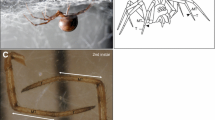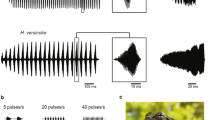Summary
Study of the stridulatory mechanism of the tree cricket Oecanthus nigricornis F. Walker has yielded the following principal results:
-
1.
The normal carrier frequency of the song is equal to the tooth-impact frequency throughout the range 3,000 Hz (at 15 °C) to 4,600 Hz (at 32 °C).
-
2.
Under conditions of thermal equilibrium, pulse frequency and tooth-impact frequency are strongly correlated: however, the two frequencies are not controlled by the same underlying mechanism, as shown by marked differences in their reaction to step changes in temperature.
-
3.
Tegminal free resonances have been identified in the range 1,000–6,900 Hz; between 3,800 and 4,600 Hz the resonances form a virtually continuous series, corresponding to modes of vibration in which the three major distal cells of the tegmen plus a variable portion of the harp oscillate as a single membrane, whose amplitude maximum is near the center of the tegmen distal to the harp (Fig. 8 A, B); these free resonances are excited by corresponding tooth-impact frequencies and are responsible for the normal carrier of the song at temperatures above 22 °C. Below 3,800 Hz free resonances have also been found and their modes of vibration identified: typically in this range a stationary node bisects each tegmen transversely, with maximum amplitude of oscillation at the distal margin of the tegmen, and a secondary maximum in the basal region near the file vein (Fig. 9 B, E). A continuous series of prominent tegminal resonances exists in the range from 5,100 to 5,850 Hz (i.e. outside the tooth-impact frequency band): these higher modes correspond to a characteristic vibration pattern in which the principal tegminal surface is trisected by two stationary nodes (Fig. 8 D, E, F). The free resonance of the harp membrane is at 6,000–6,200 Hz, well outside the range of carrier frequencies of the song; other major tegminal cells are tuned to similar frequencies. The resonance of individual tegminal cells may be excited as a secondary, low-amplitude component of the song, which is particularly evident during the early stages of each sound pulse when amplitude of the carrier is low.
-
4.
Exceptional individuals stridulate with carrier frequencies in the range 5,200–5,750 Hz, i.e. in the range of the higher tegminal resonances: in this case the carrier does not equal tooth-impact frequency. This phenomenon has been reproduced experimentally by constraining the tegmina to vibrate in the modes identified for these resonances. In both normal and experimentally modified specimens, when the carrier frequency equals a higher tegminal resonance, the carrier is excited as an ultra-subharmonic resonance of the tooth-impact rate. This phenomenon indicates the presence of nonlinearities in the tegminal resonator.
-
5.
A comparison of these results on Oecanthus with published data on Gryllus reveals significant differences, which are correlated with differences in structure between the two genera. Stridulation in Oecanthus is discussed in the light of published theories concerning the mechanism of tegminal resonance, and the concept of a resonator with continously variable tuning is supported.
Similar content being viewed by others
References
Alexander, R.D.: The taxonomy of the field crickets of the eastern United States (Orthoptera: Gryllidae: Acheta). Ann. Ent. Soc. Am. 50, 584–602 (1957)
Dinca, F., Teodosiu, C.: Nonlinear and Random Vibrations. Bucuresti and New York: Academic Press 1973
Dumortier, B.: The physical characteristics of sound emissions in Arthropoda. In: Acoustic behavior of animals. Busnel, R.G. (ed.), pp. 346–373. New York: Elsevier 1973
Fulton, B.B.: The tree crickets of New York: Life history and bionomics. N.Y. Agric. Exp. Stn. Tech. Bull. 42, 1–47 (1915)
Huber, F.: The role of the central nervous system in Orthoptera during the co-ordination and control of stridulation. In: Acoustic behavior of animals. Busnel, R.G. (ed.), pp. 440–488. New York: Elsevier 1963
Levenson, M.E.: Harmonic and subharmonic response for the Duffing equation: X+αX+βX 3 =F cosωt (α > 0). J. Appl. Phys. 20, 1045–1051 (1949)
Lutz, F.E., Hicks, W.R.: An analysis by movietone of a cricket's chirp (Gryllus assimilis). Am. Mus. Novit. 420, 1–14 (1930)
Michelsen, A., Nocke, H.: Biophysical aspects of sound communication in Insects. Adv. Insect Physiol. 10, 247–296 (1974)
Nocke, H.: Biophysik der Schallerzeugung durch die Vorderflügel der Grillen. Z. vgl. Physiol. 74, 272–314 (1971)
Pierce, G.W.: The songs of insects. Cambridge: Harvard University Press 1948
Stoker, J.J.: Nonlinear vibrations in mechanical and electrical system. New York: Wiley 1950
Timoshenko, S., Young, D.H.: Vibration problems in engineering. New York: Van Nostrand 1955
Walker, T.J.: The taxonomy and calling songs of United States tree crickets (Orthoptera: Gryllidae: Oecanthinae). I. The genus Neoxabea and the niveus and varicornis groups of the genus Oecanthus. Ann. Entomol. Soc. Am. 55, 303–322 (1962a)
Walker, T.J.: Factors responsible for intraspecific variation in the calling songs of crickets. Evolution 16, 407–428 (1962b)
Walker, T.J.: The taxonomy and calling songs of United States tree crickets (Orthoptera: Gryllidae: Oecanthinae). II. The nigricornis group of the genus Oecanthus. Ann. Entomol. Soc. Am. 56, 772–789 (1963)
Walker, T.J.: Effects of temperature on rates in poikilotherm nervous systems: evidence from the calling songs of meadow katydids (Orthoptera: Tettigoniidae: Orchelimum) and reanalysis of published data. J. comp. Physiol. 101, 57–69 (1975)
Walker, T.J., Gurney, A.B.: A new species of Oecanthus from the West Indies (Orthoptera, Gryllidae). Fla. Entomol. 43, 9–13 (1960)
Author information
Authors and Affiliations
Additional information
I thank Prof. T.J. Walker and two anonymous referees who reviewed the manuscript and provided many helpful suggestions.
Rights and permissions
About this article
Cite this article
Sismondo, E. Stridulation and tegminal resonance in the tree cricket Oecanthus nigricornis (Orthoptera: Gryllidae: Oecanthinae). J. Comp. Physiol. 129, 269–279 (1979). https://doi.org/10.1007/BF00657663
Accepted:
Published:
Issue Date:
DOI: https://doi.org/10.1007/BF00657663




